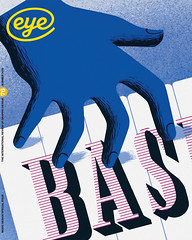Summer 2010
An Italian in Zurich
Lanfranco Bombelli: US Trade Center Graphics in Europe
Actar, USD19.95<br>Reviewed by Kerry William PurcellConcrete art was a resolutely European art form (or, to be more specific, a Swiss-German one, with the occasional foray into Italy). Its origins lie in the formation of the Allianz group (the organisation of painters and designers that came to be known as the Zürcher Konkrete) that was formed in 1936, at the heart of which were four artists: Max Bill, Camille Graeser, Verena Loewensberg and Richard Paul Lohse.
From the very beginning, this group favoured a constructive approach that used a geometric language of colour and form to solve problems on the canvas and in three-dimensional space. Working across the boundaries of art and design (although Bill and Lohse were always more associated with graphics), its practitioners believed that the rational application of geometrical principles and the avoidance of representational motifs offered an insight into the natural laws of vision. Unlike many other forms of Modernism, however, Concrete art never really transcended its native soil in its artistic form. It continues to live out a rather parochial existence (although one that has long been in decline) through a handful of small galleries.
The Allianz group disbanded shortly after a retrospective exhibition at the Zurich Helmhaus in 1954. However, during its existence the group’s approach to questions of form had shaped the design culture throughout Switzerland and played a central role in the rise of what has become known as International Typographic Style. Surrounded by numerous displays, publications, and everyday designs that used constructive methods, the young Lanfranco Bombelli immersed himself in this vibrant graphic culture when he arrived in Switzerland in the mid-1950s. He was there to study with Bill, Lohse and many other pioneers of Concrete art and, as Lanfranco Bombelli: US Trade Center Graphics in Europe demonstrates, he sought out a creative approach based ‘on a minimum of plastic means and inspired by mathematical principles’.
Passing through the eye of the Concrete art needle, Bombelli soon began to apply these principles to sketches he drafted, first in Paris and later in Barcelona, for the graphics of the exhibitions in the American Trade Centres in Milan, Stockholm, Paris and Frankfurt, from 1963 to 1978. These exhibitions were a continuation of the Marshall Plan exhibits that had peppered Europe in the years after the Second World War. Aimed at promoting new developments in electronics, pharmaceuticals and agriculture, four shows were held each month, with each exhibition including around forty displays of 2 x 4 metres each. Apart from their original panel references indicating where they should be placed on the stand, the designs in this concise book are presented as works of art. It is an approach that bears fruit. Originally intended for a functional and decorative purpose, the reproductions allow your eye to wander across Bombelli’s beautiful experiments in structure, colour and form. The array of mathematical shapes, intersecting lines, arrows, squares and cylinders are at times like a still from a piece of motion graphics. Each finely wrought drawing is imbued with a kind of petrified energy. Clearly, as they were intended to adorn displays selling visions of the future, this appearance of imminent change, of machinery about to swing into motion, was Bombelli’s intention.
It has become a cliché in graphic design history to talk about how the influx of European émigrés into America (from the 1930s to the late 1950s) gave rise to a design language that would define the look and feel of that continent’s graphic landscape.
However, the broader question of how those designers who remained in Europe throughout the war would come to shape post-war European design has received less attention. Lanfranco Bombelli: US Trade Center Graphics in Europe is a welcome contribution to our understanding of this story of graphic design in the twentieth century.
First published in Eye no. 76 vol. 19 2010
Eye is the world’s most beautiful and collectable graphic design journal, published quarterly for professional designers, students and anyone interested in critical, informed writing about graphic design and visual culture. It is available from all good design bookshops and online at the Eye shop, where you can buy subscriptions and single issues.

